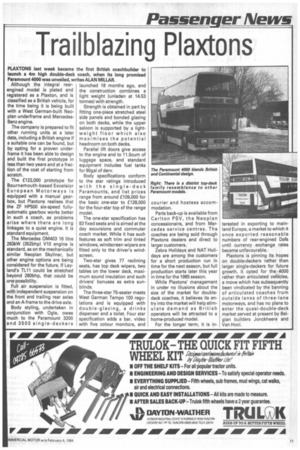Trailblazing Plaxtons
Page 19

If you've noticed an error in this article please click here to report it so we can fix it.
PLAXTONS last week became the first British coachbuilder to launch a 4m high double-deck coach, when its long promised Paramount 4000 was unveiled, writes ALAN MILLAR.
Although the integral rearengined model is plated and registered as a Plaxton, and is classified as a British vehicle, for the time being it is being built with a West German-built Neoplan under-frame and MercedesBenz engine.
The company is prepared to fit other running units at a later date, including a British engine if a suitable one can be found, but by opting for a proven underframe it has been able to design and built the first prototype in less than two years and at a fraction of the cost of starting from scratch.
The £122,000 prototype for Bournemouth-based Excelsior European Motorways is equipped with a manual gearbox, but Plaxtons realises that the ZF HP500 six-speed fullyautomatic gearbox works better in such a coach, as problems arise where there are long linkages to a quiet engine. It is standard equipment.
The Mercedes 0M403 16 litre 263kW (352bhp) V10 engine is standard, as on the mechanically similar Neoplan Skyliner, but other engine options are being considered for the future. If Leyland's TL11 could be stretched beyond 280bhp, that could be one possibility.
Full air suspension is fitted, with independent suspension on the front and trailing rear axles and an A-frame to the drive axle.
Body styling, undertaken in conjunction with Ogle, owes much to the Paramount 3200 and 3500 single-deckers launched 18 months ago, and the construction combines a light weight (unladen at 14.53 tonnes) with strength.
Strength is obtained in part by fitting one-piece stretched steel side panels and bonded glazing on both decks, while the upper saloon is supported by a lightweight floor which also maximises the potential headroom on both decks.
Parallel lift doors give access to the engine and to 11.5cum of luggage space, and standard equipment includes fuel tanks for 90gal of derv.
Body specifications conform to the star ratings introduced with the single-deck Paramounts, and list prices range from around £109,000 for the basic one-star to £128,000 for the four-star top of the range model.
The one-star specification has 83 fixed seats and is aimed at the day excursions and commuter coach market. While it has such features as soft trim and tinted windows, windscreen wipers are fitted only to the driver's windscreen.
Two-star gives 77 reclining seats, has top deck wipers, two tables on the lower deck, maximum sound insulation and such drivers' bonuses as extra sunblinds.
The three-star 75-seater meets West German Tempo 100 regulations and is equipped with double-glazing, a drinks dispenser and a toilet. Four star specification adds a bar, video with five colour monitors, and courier and hostess accommodation.
Parts back-up is available from Carlton PSV, the Neoplan concessionaire, and from Mercedes service centres. The coaches are being sold through Plaxtons dealers and direct to larger customers.
Zebra Holidays and NAT Holidays are among the customers for a short production run in time for the next season, but full production starts later this year in time for the 1985 season.
While Plaxtons' management in under no illusions about the size of the market for doubledeck coaches, it believes its entry into the market will help stimulate demand as British operators will be attracted to a home-produced model.
For the longer term, it is in
terested in exporting to mainland Europe, a market to which it once exported reasonable numbers of rear-engined Dafs until currency exchange rates became unfavourable.
Plaxtons is pinning its hopes on double-deckers rather than larger single-deckers for future growth. It opted for the 4000 rather than articulated vehicles, a move which has subsequently been vindicated by the banning of articulated coaches from outside lanes of three-lane motorways, and has no plans to enter the quasi-double-deck market served at present by Belgian builders Jonckheere and Van Hool.
































































































